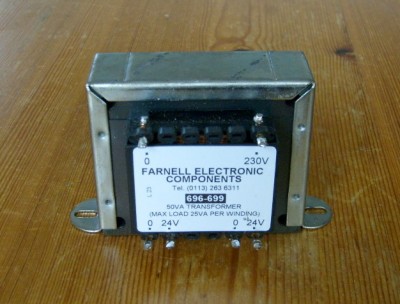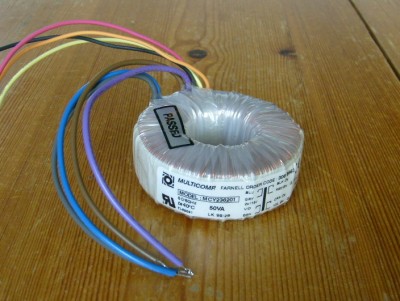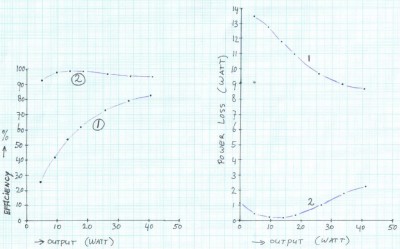 In most electronic equipment, a low-cost EI-core transformer is used, which is much less efficient than a toroidal transformer. This article shows that, quite some energy can be saved by using a more efficient transformer.
In most electronic equipment, a low-cost EI-core transformer is used, which is much less efficient than a toroidal transformer. This article shows that, quite some energy can be saved by using a more efficient transformer.
This article is based on the article Energy losses in transformers, rectifiers and mains adaptors on my website.
In electronic equipment, a transformer is used to transform the mains voltage to another (most times lower) voltage. The transformer also provides a safe separation between mains voltage and the electronic circuit.
In many equipment a transformer with EI-core can be found, mainly because of the low price of such transformers. The name EI-core refers to the shape of the transformer core, which is built up with E and I shaped metal plates. A disadvantage of the EI-core transformer is the energy loss occurring in it, by which quite some energy is lost in heat production in the transformer. When using a transformer with toroidal core, the energy losses will be much lower. With the following measurements, this is demonstrated.
I measured the energy losses of the following two transformers:

EI-core transformer 2x 24V 50 VA

Toroidal transformer 2x 9V 50VA
The transformers were loaded with several load resistors, with loading power ranging from 5 to 40 Watt. The input power of the transformer is measured with a rebuilt energy meter PM230 of brand: Brennenstuhl. The difference between input power and output power is the energy loss which is converted into heat in the transformer.
If we divide output power by input power, we get the efficiency of the transformer.
| Table 1: Losses in EI-core transformer 2x 24 V 50 VA | |||||
|---|---|---|---|---|---|
| Load resistors parallel |
Output voltage (Volt a.c.) |
Input power (Watt) |
Output power (Watt) |
Efficiency | Power loss (Watt) |
| – | 9.1 | 0.000 | 0.000 | 9.100 | |
| 1x 560 Ω | 51.0 | 18.1 | 4.645 | 0.257 | 13.455 |
| 2x 560 Ω | 50.6 | 21.9 | 9.144 | 0.418 | 12.756 |
| 3x 560 Ω | 50.2 | 25.3 | 13.500 | 0.534 | 11.800 |
| 4x 560 Ω | 49.8 | 28.7 | 17.715 | 0.617 | 10.985 |
| 6x 560 Ω | 49.1 | 35.5 | 25.830 | 0.728 | 9.670 |
| 8x 560 Ω | 48.5 | 42.6 | 33.604 | 0.789 | 8.996 |
| 10x 560 Ω | 47.7 | 49.3 | 40.630 | 0.824 | 8.670 |
| Table 2: Losses in toroidal transformer 2x 9 V 50 VA | |||||
|---|---|---|---|---|---|
| Load resistors parallel |
Output voltage (Volt a.c.) |
Input power (Watt) |
Output power (Watt) |
Efficiency | Power loss (Watt) |
| – | 1.16 | 0.000 | 0.000 | 1.160 | |
| 1x 82 Ω | 20.1 | 5.33 | 4.927 | 0.924 | 0.403 |
| 2x 82 Ω | 20.0 | 9.97 | 9.756 | 0.979 | 0.214 |
| 3x 82 Ω | 19.7 | 14.38 | 14.198 | 0.987 | 0.182 |
| 4x 82 Ω | 19.4 | 18.70 | 18.359 | 0.982 | 0.341 |
| 6x 82 Ω | 19.1 | 27.70 | 26.693 | 0.964 | 1.007 |
| 8x 82 Ω | 18.7 | 35.90 | 34.116 | 0.950 | 1.784 |
| 10x 82 Ω | 18.4 | 43.50 | 41.288 | 0.949 | 2.212 |

This graphs show the results of the measurements.
The left graph shows the efficiency of the transformer.
The right graph shows the power loss in the transformer.
Line 1 is for the EI-core transformer.
Line 2 is for the toroidal transformer.
We see the toroidal transformer gives much less losses then the EI-core transformer.
Encouraged by these results, I replaced in my modem and aerial amplifier the EI-core transformer with a toroidal transformer as well as some other energy saving measures. Through this I save tens of kWh per year.




